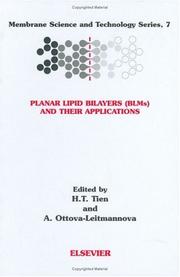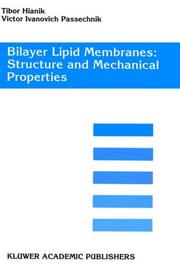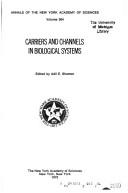| Listing 1 - 9 of 9 |
Sort by
|
Book
ISBN: 9780080931289 0080931286 9781299528888 1299528880 9780444521538 0444521534 Year: 2013 Publisher: Amsterdam ; Boston : Elsevier/AP,
Abstract | Keywords | Export | Availability | Bookmark
 Loading...
Loading...Choose an application
- Reference Manager
- EndNote
- RefWorks (Direct export to RefWorks)
An Introduction to Biological Membranes: From Bilayers to Rafts covers many aspects of membrane structure/function that bridges membrane biophysics and cell biology. Offering cohesive, foundational information, this publication is valuable for advanced undergraduate students, graduate students and membranologists who seek a broad overview of membrane science. Brings together different facets of membrane research in a universally understandable manner Emphasis on the historical development of the field Topics include membrane sugars, membrane models, membrane isolation methods, and membrane transport.
Membranes (Biology) --- Bilayer lipid membranes. --- Bilayer phospholipid membranes --- Bimolecular lipid membranes --- Black lipid membranes --- BLMs (Membranes) --- Lipid bilayer membranes --- Lipid bilayers --- Lipid bimolecular membranes --- Phospholipid bilayers --- Biological models --- Cell membranes --- Lipid membranes --- Biological membranes --- Biomembranes --- Biological interfaces --- Protoplasm

ISBN: 0444509402 9786611144920 1281144924 0080539033 9780444509406 9780080539034 Year: 2003 Volume: 7 Publisher: Amsterdam ; Boston : Elsevier,
Abstract | Keywords | Export | Availability | Bookmark
 Loading...
Loading...Choose an application
- Reference Manager
- EndNote
- RefWorks (Direct export to RefWorks)
The lipid bilayer is the most basic structural element of cell membranes. A wide range of topics are covered in this volume, from the origin of the lipid bilayer concept, to current applications and experimental techniques. Each chapter in this volume is self-contained and describes a group's research, providing detailed methodology and key references useful for researchers. Lipid bilayer research is of great interest to many because of it's interdisciplinary nature.·Provides an overview of decades of research on the lipid bilayer·38 contributed chapters, by leading scientists, cov
Bilayer lipid membranes. --- Membranes lipidiques bimoléculaires --- 544.7 --- Chemistry of surface phenomena and colloids --- 544.7 Chemistry of surface phenomena and colloids --- Membranes lipidiques bimoléculaires --- Bilayer lipid membranes --- Bilayer phospholipid membranes --- Bimolecular lipid membranes --- Black lipid membranes --- BLMs (Membranes) --- Lipid bilayer membranes --- Lipid bilayers --- Lipid bimolecular membranes --- Phospholipid bilayers --- Biological models --- Cell membranes --- Lipid membranes

ISBN: 0792335511 9780792335511 Year: 1995 Publisher: Dordrecht Kluwer
Abstract | Keywords | Export | Availability | Bookmark
 Loading...
Loading...Choose an application
- Reference Manager
- EndNote
- RefWorks (Direct export to RefWorks)
Bilayer lipid membranes --- 577.115 --- 577.352.3 --- Bilayer phospholipid membranes --- Bimolecular lipid membranes --- Black lipid membranes --- BLMs (Membranes) --- Lipid bilayer membranes --- Lipid bilayers --- Lipid bimolecular membranes --- Phospholipid bilayers --- Biological models --- Cell membranes --- Lipid membranes --- 577.115 Lipids. Lipoids. Fats. Fat-like substances --- Lipids. Lipoids. Fats. Fat-like substances --- 577.352.3 Natural (biological) membranes --- Natural (biological) membranes
Book
ISBN: 0045740283 9401096309 9401096287 Year: 1985 Publisher: Boston Allen and Unwin
Abstract | Keywords | Export | Availability | Bookmark
 Loading...
Loading...Choose an application
- Reference Manager
- EndNote
- RefWorks (Direct export to RefWorks)
577.352 --- Bilayer lipid membranes --- Cell membranes --- Chemistry, Physical organic --- Cytochemistry --- Cell chemistry --- Biochemistry --- Cytology --- Chemistry, Organic --- Chemistry, Physical and theoretical --- Cell surfaces --- Cytoplasmic membranes --- Plasma membranes --- Plasmalemma --- Membranes (Biology) --- Bilayer phospholipid membranes --- Bimolecular lipid membranes --- Black lipid membranes --- BLMs (Membranes) --- Lipid bilayer membranes --- Lipid bilayers --- Lipid bimolecular membranes --- Phospholipid bilayers --- Biological models --- Lipid membranes --- Membrane biophysics --- 577.352 Membrane biophysics --- Physical organic chemistry --- Glycocalyces --- Cell membranes.

ISBN: 0890720185 9780890720189 Year: 1975 Volume: 264 Publisher: New York, N.Y. New York Academy of Sciences
Abstract | Keywords | Export | Availability | Bookmark
 Loading...
Loading...Choose an application
- Reference Manager
- EndNote
- RefWorks (Direct export to RefWorks)
Biological Transport --- Cell Membrane Permeability --- Bilayer lipid membranes --- -Biological transport --- -Ion-permeable membranes --- -Membranes (Biology) --- -Ion exchange membranes --- Permeable membranes (Electrodialysis) --- Permselective membranes --- Electrodes, Ion selective --- Electrodialysis --- Ion exchange --- Membranes (Technology) --- Permeability, Cell Membrane --- Ionophores --- Membrane transport --- Passive transport, Biological --- Physiological transport --- Transport, Biological --- Diffusion --- Osmosis --- Bilayer phospholipid membranes --- Bimolecular lipid membranes --- Black lipid membranes --- BLMs (Membranes) --- Lipid bilayer membranes --- Lipid bilayers --- Lipid bimolecular membranes --- Phospholipid bilayers --- Biological models --- Cell membranes --- Lipid membranes --- Biologic Transport --- Transport, Biologic --- Transport Vesicles --- Membrane Transport Proteins --- Congresses --- Biological transport --- Membranes (Biology) --- Ion-permeable membranes --- Biomembranes
Book
ISBN: 3319563483 3319563475 Year: 2018 Publisher: Cham : Springer International Publishing : Imprint: Springer,
Abstract | Keywords | Export | Availability | Bookmark
 Loading...
Loading...Choose an application
- Reference Manager
- EndNote
- RefWorks (Direct export to RefWorks)
This book is the first collection of lipid-membrane research conducted by leading mechanicians and experts in continuum mechanics. It brings the overall intellectual framework afforded by modern continuum mechanics to bear on a host of challenging problems in lipid membrane physics. These include unique and authoritative treatments of differential geometry, shape elasticity, surface flow and diffusion, interleaf membrane friction, phase transitions, electroelasticity and flexoelectricity, and computational modelling. .
Bilayer lipid membranes. --- Biomechanics. --- Biological mechanics --- Mechanical properties of biological structures --- Bilayer phospholipid membranes --- Bimolecular lipid membranes --- Black lipid membranes --- BLMs (Membranes) --- Lipid bilayer membranes --- Lipid bilayers --- Lipid bimolecular membranes --- Phospholipid bilayers --- Engineering. --- Differential geometry. --- Thermodynamics. --- Heat engineering. --- Heat transfer. --- Mass transfer. --- Continuum mechanics. --- Continuum Mechanics and Mechanics of Materials. --- Differential Geometry. --- Engineering Thermodynamics, Heat and Mass Transfer. --- Biophysics --- Mechanics --- Contractility (Biology) --- Biological models --- Cell membranes --- Lipid membranes --- Mechanics. --- Mechanics, Applied. --- Global differential geometry. --- Solid Mechanics. --- Construction --- Industrial arts --- Technology --- Geometry, Differential --- Applied mechanics --- Engineering, Mechanical --- Engineering mathematics --- Classical mechanics --- Newtonian mechanics --- Physics --- Dynamics --- Quantum theory --- Chemistry, Physical and theoretical --- Heat --- Heat-engines --- Differential geometry --- Mass transport (Physics) --- Thermodynamics --- Transport theory --- Heat transfer --- Thermal transfer --- Transmission of heat --- Energy transfer --- Mechanical engineering
Book
Year: 2021 Publisher: Basel, Switzerland MDPI - Multidisciplinary Digital Publishing Institute
Abstract | Keywords | Export | Availability | Bookmark
 Loading...
Loading...Choose an application
- Reference Manager
- EndNote
- RefWorks (Direct export to RefWorks)
This Special Issue is one of the first for the new MDPI flagship journal Chemistry (ISSN 2624-8549) which has a broad remit for publishing original research in all areas of chemistry. The theme of this issue is Supramolecular Chemistry in the 3rd Millennium and I am sure that this topic will attract many exciting contributions. We chose this topic because it encompasses the unity of contemporary pluridisciplinary science, in which organic, inorganic, physical and theoretical chemists work together with molecular biologists and physicists to develop a systems-level understanding of molecular interactions. The description of supramolecular chemistry as ‘chemistry beyond the molecule’ (Jean-Marie Lehn, Nobel Lecture and Gautam R. Desiraju, Nature, 2001, 412, 397) addresses the wide variety of weak, non-covalent interactions that are the basis for the assembly of supramolecular architectures, molecular receptors and molecular recognition, programed molecular systems, dynamic combinatorial libraries, coordination networks and functional supramolecular materials. We welcome submissions from all disciplines involved in this exciting and evolving area of science.
Technology: general issues --- anion binding --- chloride receptor --- switchable system --- hydroquinone --- redox switch --- metal-organic frameworks --- vapour sorption --- solvatochromism --- desorption kinetics --- ion-channels --- crown-ethers --- bilayer membranes --- self-assembly --- supramolecular chemistry --- host-guest chemistry --- coordination cage --- catalysis --- crystal structure --- copper chloride complexes --- H-bonding pattern --- tetrazole ligands --- X-ray diffraction --- Hirshfeld surfaces --- uranium(VI) --- carboxylates --- capsules --- structure --- luminescence --- multicomponent cocrystal --- cocrystallization mechanism --- cocrystal synthesis --- crystal engineering --- porous material --- molecular recognition --- halogen bond --- co-crystal --- molecular tecton --- binary solid --- network structure --- σ-hole --- molecular electrostatic potential --- calixarenes --- coordination clusters --- manganese --- molecular magnetism --- host-guest interaction --- cucurbit[7]uril --- 4-pyrrolidinopyridinium --- copper complexes --- chlorido ligand displacement --- catalysis regulation --- Schiff base ligands --- urea hydrolysis --- coordination chemistry --- hydrogen bonds --- metalla-assemblies --- coordination-driven self-assembly --- orthogonality --- ligands --- metal ions --- complementarity --- hydrogen bonding --- cyclotricatechylene --- metal-organic cage --- helicate --- metallosupramolecular --- chirality --- copper(II) complexes --- pyrazolato ligands --- supramolecular assembly --- X-ray crystallography --- magnetic susceptibility --- EPR spectroscopy --- isotropic exchange --- antisymmetric exchange --- dipolar interaction --- DFT calculations --- hydrogen bond --- pyrazine --- chloropyrazine --- chloropyrazin-2-amine --- copper halide --- supramolecular structure --- conformational polymorphism --- intermolecular contacts --- N,N',N",N‴-Tetraisopropylpyrophosphoramide --- pyrophosphoramide --- synthons --- supramolecular motifs --- anion binding --- chloride receptor --- switchable system --- hydroquinone --- redox switch --- metal-organic frameworks --- vapour sorption --- solvatochromism --- desorption kinetics --- ion-channels --- crown-ethers --- bilayer membranes --- self-assembly --- supramolecular chemistry --- host-guest chemistry --- coordination cage --- catalysis --- crystal structure --- copper chloride complexes --- H-bonding pattern --- tetrazole ligands --- X-ray diffraction --- Hirshfeld surfaces --- uranium(VI) --- carboxylates --- capsules --- structure --- luminescence --- multicomponent cocrystal --- cocrystallization mechanism --- cocrystal synthesis --- crystal engineering --- porous material --- molecular recognition --- halogen bond --- co-crystal --- molecular tecton --- binary solid --- network structure --- σ-hole --- molecular electrostatic potential --- calixarenes --- coordination clusters --- manganese --- molecular magnetism --- host-guest interaction --- cucurbit[7]uril --- 4-pyrrolidinopyridinium --- copper complexes --- chlorido ligand displacement --- catalysis regulation --- Schiff base ligands --- urea hydrolysis --- coordination chemistry --- hydrogen bonds --- metalla-assemblies --- coordination-driven self-assembly --- orthogonality --- ligands --- metal ions --- complementarity --- hydrogen bonding --- cyclotricatechylene --- metal-organic cage --- helicate --- metallosupramolecular --- chirality --- copper(II) complexes --- pyrazolato ligands --- supramolecular assembly --- X-ray crystallography --- magnetic susceptibility --- EPR spectroscopy --- isotropic exchange --- antisymmetric exchange --- dipolar interaction --- DFT calculations --- hydrogen bond --- pyrazine --- chloropyrazine --- chloropyrazin-2-amine --- copper halide --- supramolecular structure --- conformational polymorphism --- intermolecular contacts --- N,N',N",N‴-Tetraisopropylpyrophosphoramide --- pyrophosphoramide --- synthons --- supramolecular motifs
Book
Year: 2021 Publisher: Basel, Switzerland MDPI - Multidisciplinary Digital Publishing Institute
Abstract | Keywords | Export | Availability | Bookmark
 Loading...
Loading...Choose an application
- Reference Manager
- EndNote
- RefWorks (Direct export to RefWorks)
This Special Issue is one of the first for the new MDPI flagship journal Chemistry (ISSN 2624-8549) which has a broad remit for publishing original research in all areas of chemistry. The theme of this issue is Supramolecular Chemistry in the 3rd Millennium and I am sure that this topic will attract many exciting contributions. We chose this topic because it encompasses the unity of contemporary pluridisciplinary science, in which organic, inorganic, physical and theoretical chemists work together with molecular biologists and physicists to develop a systems-level understanding of molecular interactions. The description of supramolecular chemistry as ‘chemistry beyond the molecule’ (Jean-Marie Lehn, Nobel Lecture and Gautam R. Desiraju, Nature, 2001, 412, 397) addresses the wide variety of weak, non-covalent interactions that are the basis for the assembly of supramolecular architectures, molecular receptors and molecular recognition, programed molecular systems, dynamic combinatorial libraries, coordination networks and functional supramolecular materials. We welcome submissions from all disciplines involved in this exciting and evolving area of science.
Technology: general issues --- anion binding --- chloride receptor --- switchable system --- hydroquinone --- redox switch --- metal-organic frameworks --- vapour sorption --- solvatochromism --- desorption kinetics --- ion-channels --- crown-ethers --- bilayer membranes --- self-assembly --- supramolecular chemistry --- host–guest chemistry --- coordination cage --- catalysis --- crystal structure --- copper chloride complexes --- H-bonding pattern --- tetrazole ligands --- X-ray diffraction --- Hirshfeld surfaces --- uranium(VI) --- carboxylates --- capsules --- structure --- luminescence --- multicomponent cocrystal --- cocrystallization mechanism --- cocrystal synthesis --- crystal engineering --- porous material --- molecular recognition --- halogen bond --- co-crystal --- molecular tecton --- binary solid --- network structure --- σ-hole --- molecular electrostatic potential --- calixarenes --- coordination clusters --- manganese --- molecular magnetism --- host–guest interaction --- cucurbit[7]uril --- 4-pyrrolidinopyridinium --- copper complexes --- chlorido ligand displacement --- catalysis regulation --- Schiff base ligands --- urea hydrolysis --- coordination chemistry --- hydrogen bonds --- metalla-assemblies --- coordination-driven self-assembly --- orthogonality --- ligands --- metal ions --- complementarity --- hydrogen bonding --- cyclotricatechylene --- metal–organic cage --- helicate --- metallosupramolecular --- chirality --- copper(II) complexes --- pyrazolato ligands --- supramolecular assembly --- X-ray crystallography --- magnetic susceptibility --- EPR spectroscopy --- isotropic exchange --- antisymmetric exchange --- dipolar interaction --- DFT calculations --- hydrogen bond --- pyrazine --- chloropyrazine --- chloropyrazin-2-amine --- copper halide --- supramolecular structure --- conformational polymorphism --- intermolecular contacts --- N,N′,N″,N‴-Tetraisopropylpyrophosphoramide --- pyrophosphoramide --- synthons --- supramolecular motifs --- n/a --- host-guest chemistry --- host-guest interaction --- metal-organic cage --- N,N',N",N‴-Tetraisopropylpyrophosphoramide
Book
Year: 2021 Publisher: Basel, Switzerland MDPI - Multidisciplinary Digital Publishing Institute
Abstract | Keywords | Export | Availability | Bookmark
 Loading...
Loading...Choose an application
- Reference Manager
- EndNote
- RefWorks (Direct export to RefWorks)
This Special Issue is one of the first for the new MDPI flagship journal Chemistry (ISSN 2624-8549) which has a broad remit for publishing original research in all areas of chemistry. The theme of this issue is Supramolecular Chemistry in the 3rd Millennium and I am sure that this topic will attract many exciting contributions. We chose this topic because it encompasses the unity of contemporary pluridisciplinary science, in which organic, inorganic, physical and theoretical chemists work together with molecular biologists and physicists to develop a systems-level understanding of molecular interactions. The description of supramolecular chemistry as ‘chemistry beyond the molecule’ (Jean-Marie Lehn, Nobel Lecture and Gautam R. Desiraju, Nature, 2001, 412, 397) addresses the wide variety of weak, non-covalent interactions that are the basis for the assembly of supramolecular architectures, molecular receptors and molecular recognition, programed molecular systems, dynamic combinatorial libraries, coordination networks and functional supramolecular materials. We welcome submissions from all disciplines involved in this exciting and evolving area of science.
anion binding --- chloride receptor --- switchable system --- hydroquinone --- redox switch --- metal-organic frameworks --- vapour sorption --- solvatochromism --- desorption kinetics --- ion-channels --- crown-ethers --- bilayer membranes --- self-assembly --- supramolecular chemistry --- host–guest chemistry --- coordination cage --- catalysis --- crystal structure --- copper chloride complexes --- H-bonding pattern --- tetrazole ligands --- X-ray diffraction --- Hirshfeld surfaces --- uranium(VI) --- carboxylates --- capsules --- structure --- luminescence --- multicomponent cocrystal --- cocrystallization mechanism --- cocrystal synthesis --- crystal engineering --- porous material --- molecular recognition --- halogen bond --- co-crystal --- molecular tecton --- binary solid --- network structure --- σ-hole --- molecular electrostatic potential --- calixarenes --- coordination clusters --- manganese --- molecular magnetism --- host–guest interaction --- cucurbit[7]uril --- 4-pyrrolidinopyridinium --- copper complexes --- chlorido ligand displacement --- catalysis regulation --- Schiff base ligands --- urea hydrolysis --- coordination chemistry --- hydrogen bonds --- metalla-assemblies --- coordination-driven self-assembly --- orthogonality --- ligands --- metal ions --- complementarity --- hydrogen bonding --- cyclotricatechylene --- metal–organic cage --- helicate --- metallosupramolecular --- chirality --- copper(II) complexes --- pyrazolato ligands --- supramolecular assembly --- X-ray crystallography --- magnetic susceptibility --- EPR spectroscopy --- isotropic exchange --- antisymmetric exchange --- dipolar interaction --- DFT calculations --- hydrogen bond --- pyrazine --- chloropyrazine --- chloropyrazin-2-amine --- copper halide --- supramolecular structure --- conformational polymorphism --- intermolecular contacts --- N,N′,N″,N‴-Tetraisopropylpyrophosphoramide --- pyrophosphoramide --- synthons --- supramolecular motifs --- n/a --- host-guest chemistry --- host-guest interaction --- metal-organic cage --- N,N',N",N‴-Tetraisopropylpyrophosphoramide
| Listing 1 - 9 of 9 |
Sort by
|

 Search
Search Feedback
Feedback About UniCat
About UniCat  Help
Help News
News